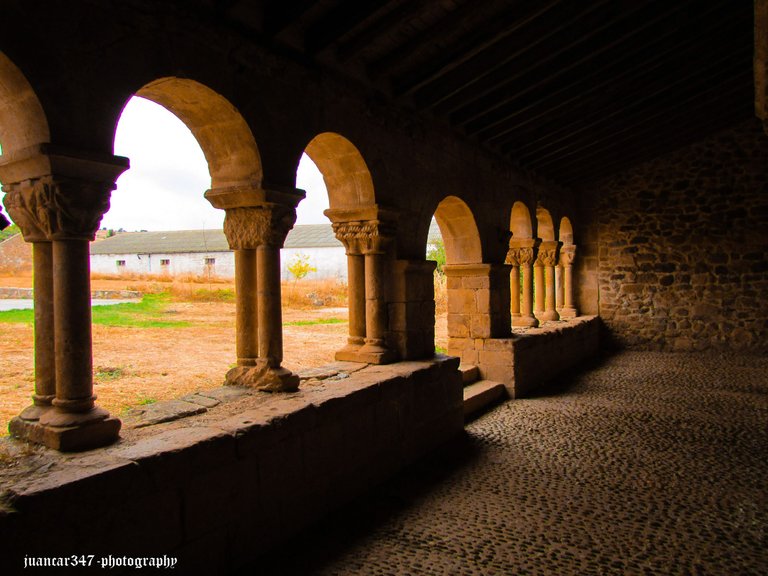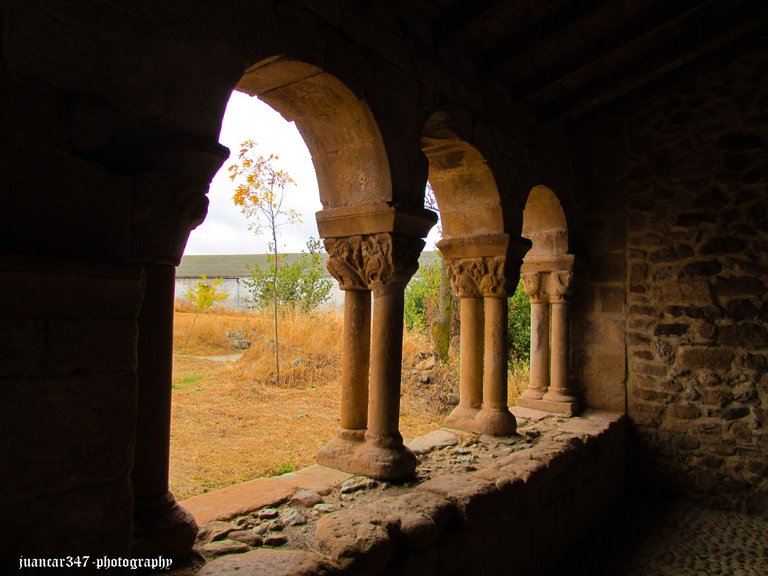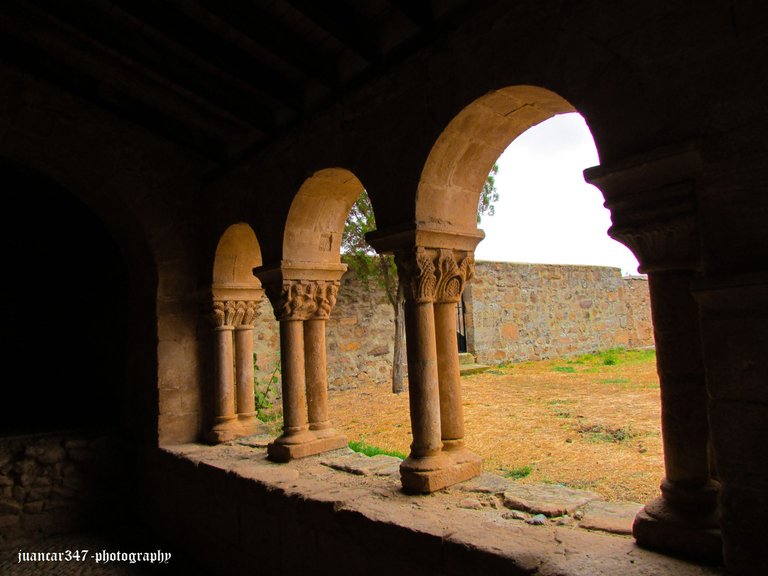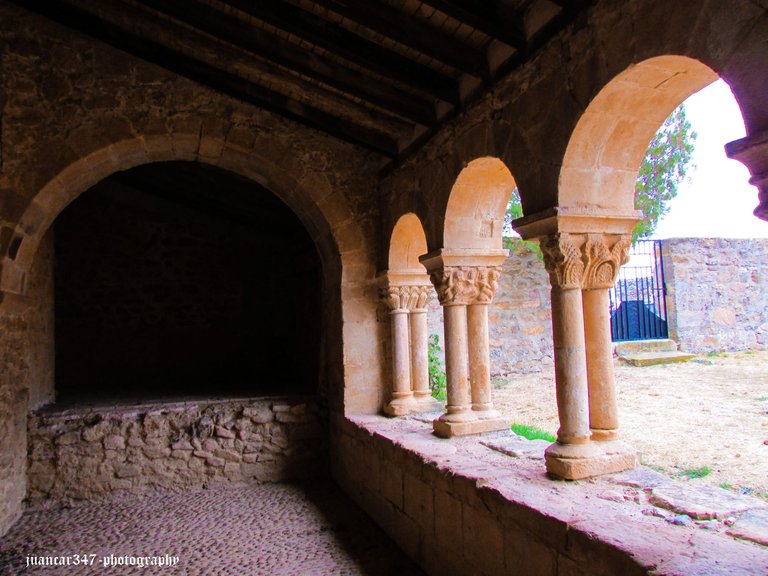[ENG-SPN] Churches and legends / Iglesias y leyendas

I remember that when the reading virus unexpectedly came to visit me, I was barely a boy who did not raise two miserable feet off the ground, being two books, used and put into circulation by Editorial Araluce in 1926, within a collection of Classics. Universal, adapted for youth –'The Odyssey', by Homer and a phenomenal Anonymous, as is the legend of 'The Seven Infants of Lara'- which, at the same time, awakened within me that taste for adventure, that, fortunately, it has not suffered one iota over the years, not even now, that, like the hermetic Italian poet, Dante Alighieri, I too have long since crossed the inevitable meridians of the middle of my existence. These were undoubtedly difficult times for those generations of Spaniards whose hearts would be broken by one of the two Spains -as the poet Antonio Machado well warned- that we were born at a time when in schools, both public as private, the axiom that the letter with blood enters was still kept alive, the discipline being little less than similar to that of the military barracks. Our apparent barbarity, then, was constantly threatened by the cane and the slap, which, though medieval techniques, nevertheless served to keep our ardor and impertinence at bay. Perhaps for this reason, because of the fear of physical punishment and also, why not say it, because of the shame of coming home feeling like a failure when some failing sullied our report card, we tried to apply ourselves more. At that time, I already realized, without having to resort to specialists in clairvoyance, that character influenced the ease or difficulty when dealing with certain subjects. In that sense, I never had any doubts that a dreamy character was more receptive to being seduced by letters, while a less cantilever and more consistent character tended towards mathematics and science. By the time Kipling appeared in my life -before, there were at least two other talented adventurers, such as Jules Verne and Emilio Salgari- with his invaluable recommendation to get to know that world that is out there, the pleasure of Literature and the desire of flying gradually became the pleasure of the experience.

Although tedious, as all precedents always seem, no matter how much Chesterton insists on going back to Genesis for any self-respecting biography or pseudo-biography, they can be useful to better understand, as something decidedly wonderful what it meant, for that dreamy spirit and altered by the restless ass syndrome, Ulysses type, begin to explore that world out there, which, judging by everything I read, must have been, to say the least, exceptional. Bearing this in mind, you can understand the enthusiasm that preceded visiting, personally, those places that until then you had only enjoyed in your imagination. Accessing them meant, in some way, participating in that story, in that event or in that phenomenal legend, which, in some way, led you to get involved, to want to know more; In short: to go further. For this reason, this Romanesque church, nestled in front of the popular Castilian Land Saw -a geographical accident shared by Soria and Burgos- was not only one of the first I saw, it makes it, believe it or not, a lifetime, but which, moreover, is one of those special places, sponsored by legend and tradition, where there is, without going any further, a close relationship with the legend of those ill-fated seven infants of Lara, whose adventures and misadventures, such emotional force meant for that distant dreamer's apprentice. Because here, precisely, the legend tells that the seven arches of the marvelous porticoed gallery of this ancient church were made by the seven infants, who, harassed by the Muslims, sought refuge and sanctuary inside with their horses. And of course, the environment, the Land Saw, is also related to them, as the legend also tells that it receives its name precisely because the unfortunate Castilian infantrymen were surprised there, while they were replenishing their strength, having lunch in the that, at the time and until the destructive action of men, was an ancient prehistoric dolmen, currently disappeared.

Recuerdo, que, cuando el virus de la lectura vino inesperadamente a visitarme, apenas era un muchacho que no levantaba dos miserables palmos del suelo, siendo dos libros, usados y puestos en circulación por la Editorial Araluce en 1926, dentro de una colección de Clásicos Universales, adaptados para la juventud –‘La Odisea’, de Homero y un fenomenal Anónimo, como es la leyenda de ‘Los Siete Infantes de Lara’- los que, a la vez, hicieron despertar en mi interior ese gusto por la aventura, que, afortunadamente, no se ha visto resentido ni un ápice al paso de los años, ni siquiera ahora, que, al igual que el hermético poeta italiano, Dante Alighieri, yo también hace tiempo que crucé los inevitables meridianos de la mitad de mi existencia. Fueron unos tiempos, sin duda, difíciles, para aquellas generaciones de españolitos a los que una de las dos Españas habría de partirnos el corazón -como bien advirtió el poeta, Antonio Machado- que nacimos en una época, donde en las escuelas, tanto públicas como privadas, todavía se mantenía vivo el axioma de que la letra con sangre entra, siendo la disciplina, poco menos que similar a la de los cuarteles militares. Nuestra aparente barbarie, pues, se veía constantemente amenazada por la vara y el bofetón, que, aunque eran técnicas medievales, servían, no obstante, para mantener a raya nuestro ardor e impertinencia. Quizás por eso, por el temor al castigo físico y también, por qué no decirlo, por la vergüenza que nos daba llegar a casa sintiéndonos fracasados cuando algún suspenso mancillaba nuestra cartilla de calificaciones, procurábamos aplicarnos más. Por aquél entonces, ya me di cuenta, sin necesidad de recurrir a especialistas en videncia, que el carácter influía en la facilidad o dificultad a la hora de tratar determinadas materias. En ese sentido, nunca tuve dudas de que un carácter soñador, era más receptivo a dejarse seducir por las letras, mientras que un carácter menos voladizo y más consecuente, tendía a la matemática y a la ciencia. Para cuando apareció Kipling en mi vida -antes, hubieron, al menos, otros dos talentosos de la aventura, como Julio Verne y Emilio Salgari- con su inestimable recomendación de conocer ese mundo que hay ahí fuera, el placer de la Literatura y el deseo de volar, se fueron convirtiendo, gradualmente, en el placer de la experiencia.

Aunque tediosos, como suelen parecer siempre todos los antecedentes, por mucho que insista Chesterton en remontarse hasta el Génesis para toda biografía o pseudo biografía que se precie, pueden ser útiles para entender mejor, como algo decididamente maravilloso lo que significó, para ese espíritu soñador y alterado por el síndrome del culo inquieto, tipo Ulises, comenzar a explorar ese mundo de ahí fuera, que, a juzgar por todo lo leído, debía de ser, cuando menos, excepcional. Teniendo esto en cuenta, pueden entender el entusiasmo que precedía a visitar, personalmente, esos lugares que hasta entonces habías disfrutado solo con la imaginación. Acceder a ellos, significaba, de alguna manera, participar en esa historia, en ese acontecimiento o en esa fenomenal leyenda, que, de alguna manera, te inducía a implicarte, a querer saber más; en definitiva: a llegar más lejos. Por eso, esta iglesia románica, enclavada frente a la popular Sierra del Almuerzo castellana -accidente geográfico que comparten Soria y Burgos- no sólo fue una de las primeras que conocí, hace de ello, se lo crean o no, toda una vida, sino que, además, es uno de esos lugares especiales, apadrinados por la leyenda y la tradición, donde se sitúa, sin ir más lejos, una estrecha relación con la leyenda de esos malogrados siete infantes de Lara, cuyas aventuras y desventuras, tanta fuerza emotiva significó para aquél lejano aprendiz de soñador. Porque aquí, precisamente, cuenta la leyenda que los siete arcos de la maravillosa galería porticada de esta antiquísima iglesia, fueron realizados por los siete infantes, que, hostigados por los musulmanes, buscaron, junto a sus cabalgaduras, refugio y santuario en su interior. Y desde luego, el entorno, la Sierra del Almuerzo, también está relacionado con ellos, pues cuenta, además, la leyenda, que recibe su nombre, precisamente porque en ella, fueron sorprendidos los desventurados infantes castellanos, mientras reponían fuerzas, almorzando en lo que, en su momento y hasta la acción destructiva de los hombres, fuera un antiguo dolmen prehistórico, actualmente desaparecido.

NOTICE: Both the text and the photographs that accompany it are my exclusive intellectual property and, therefore, are subject to my Copyright.
AVISO: Tanto el texto, como las fotografías que lo acompañan, son de mi exclusiva propiedad intelectual y por lo tanto, están sujetos a mis Derechos de Autor.
Beautiful photos my friend thanks for sharing 👍🏾 @tipu curate
Upvoted 👌 (Mana: 6/36) Liquid rewards.
Thank-you
Thank-you very much, my friend. Greetings
Welcome my friend 🤝🏾
Greetings, my friend
The photos are very beautiful, this church reminds me of the one I visited in Albania-Zvernec.
Possibly, the one you saw in Albania belonged to the same Byzantine style as this one, since Byzantium, present-day Turkey, was the link through which this art is supposed to have been introduced to the West. Thank you very much for your comment and best regards.
You're welcome.